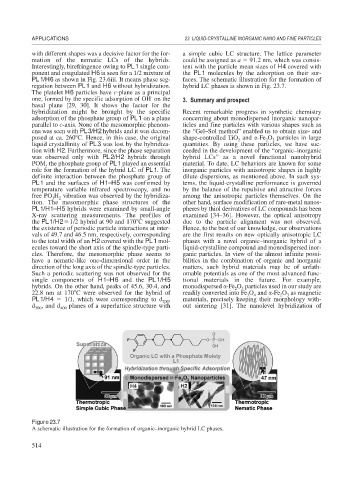Page 542 - Book Hosokawa Nanoparticle Technology Handbook
P. 542
APPLICATIONS 23 LIQUID-CRYSTALLINE INORGANIC NANO AND FINE PARTICLES
with different shapes was a decisive factor for the for- a simple cubic LC structure. The lattice parameter
mation of the nematic LCs of the hybrids. could be assigned as a 91.2 nm, which was consis-
Interestingly, birefringence owing to PL1 single com- tent with the particle mean sizes of H4 covered with
ponent and coagulated H6 is seen for a 1/2 mixture of the PL1 molecules by the adsorption on their sur-
PL1/H6 as shown in Fig. 23.6iii. It means phase seg- faces. The schematic illustration for the formation of
regation between PL1 and H6 without hybridization. hybrid LC phases is shown in Fig. 23.7.
The platelet H6 particles have c-plane as a principal
-
one, formed by the specific adsorption of OH on the 3. Summary and prospect
basal plane [29, 30]. It shows the factor for the
hybridization might be brought by the specific Recent remarkable progress in synthetic chemistry
adsorption of the phosphate group of PL1 on a plane concerning about monodispersed inorganic nanopar-
parallel to c-axis. None of the mesomorphic phenom- ticles and fine particles with various shapes such as
ena was seen with PL3/H2 hybrids and it was decom- the “Gel–Sol method” enabled us to obtain size- and
posed at ca. 260 C. Hence, in this case, the original shape-controlled TiO and -Fe O particles in large
2
3
2
liquid crystallinity of PL3 was lost by the hybridiza- quantities. By using these particles, we have suc-
tion with H2. Furthermore, since the phase separation ceeded in the development of the “organic–inorganic
was observed only with PL2/H2 hybrids through hybrid LCs” as a novel functional nanohybrid
POM, the phosphate group of PL1 played an essential material. To date, LC behaviors are known for some
role for the formation of the hybrid LC of PL1. The inorganic particles with anisotropic shapes in highly
definite interaction between the phosphate group of dilute dispersions, as mentioned above. In such sys-
PL1 and the surfaces of H1–H5 was confirmed by tems, the liquid-crystalline performance is governed
temperature variable infrared spectroscopy, and no by the balance of the repulsive and attractive forces
free PO H vibration was observed by the hybridiza- among the anisotropic particles themselves. On the
3
2
tion. The mesomorphic phase structures of the other hand, surface modification of rare-metal nanos-
PL1/H1–H5 hybrids were examined by small-angle pheres by thiol derivatives of LC compounds has been
X-ray scattering measurements. The profiles of examined [34–36]. However, the optical anisotropy
the PL1/H2 1/2 hybrid at 90 and 170 C suggested due to the particle alignment was not observed.
the existence of periodic particle interactions at inter- Hence, to the best of our knowledge, our observations
vals of 49.7 and 46.5 nm, respectively, corresponding are the first results on new optically anisotropic LC
to the total width of an H2 covered with the PL1 mol- phases with a novel organic–inorganic hybrid of a
ecules toward the short axis of the spindle-type parti- liquid-crystalline compound and monodispersed inor-
cles. Therefore, the mesomorphic phase seems to ganic particles. In view of the almost infinite possi-
have a nematic-like one-dimensional order in the bilities in the combination of organic and inorganic
direction of the long axis of the spindle-type particles. matters, such hybrid materials may be of unfath-
Such a periodic scattering was not observed for the omable potentials as one of the most advanced func-
single components of H1–H6 and the PL1/H5 tional materials in the future. For example,
hybrids. On the other hand, peaks of 45.6, 30.4, and monodispersed -Fe O particles used in our study are
3
2
22.8 nm at 170 C were observed for the hybrid of readily converted into Fe O and -Fe O as magnetic
3
3
4
2
PL1/H4 1/1, which were corresponding to d , materials, precisely keeping their morphology with-
200
d 300 , and d 400 planes of a superlattice structure with out sintering [31]. The nanolevel hybridization of
Figure 23.7
A schematic illustration for the formation of organic–inorganic hybrid LC phases.
514

